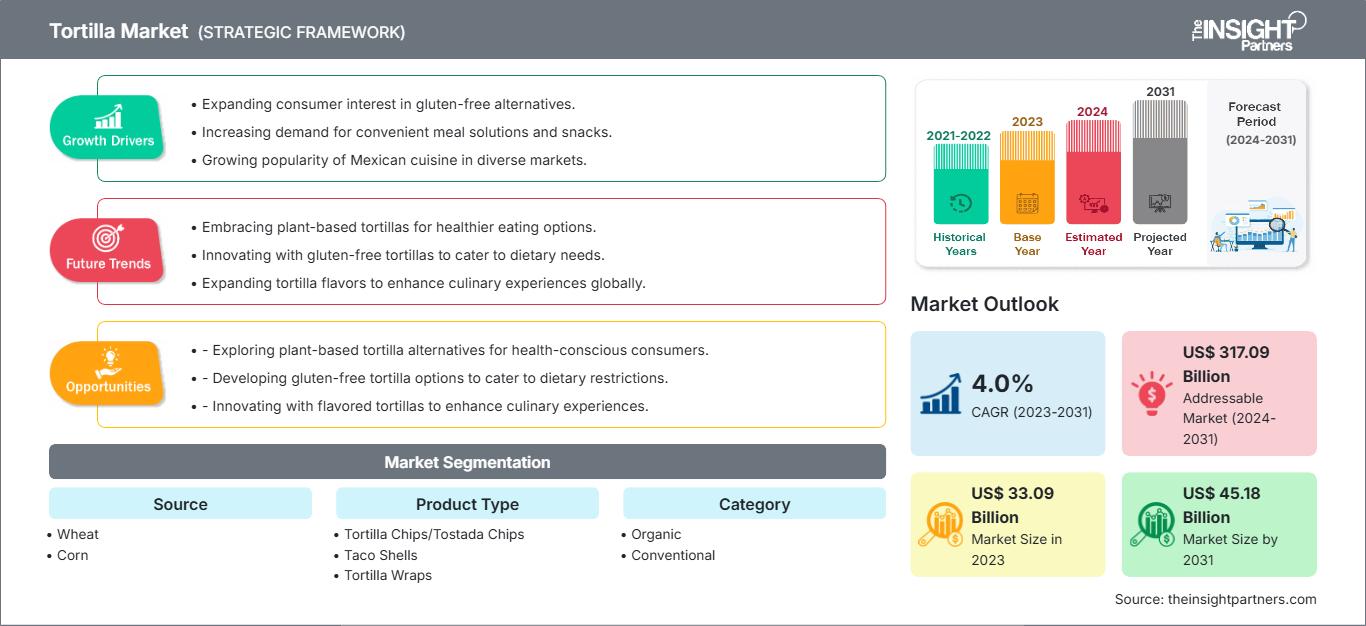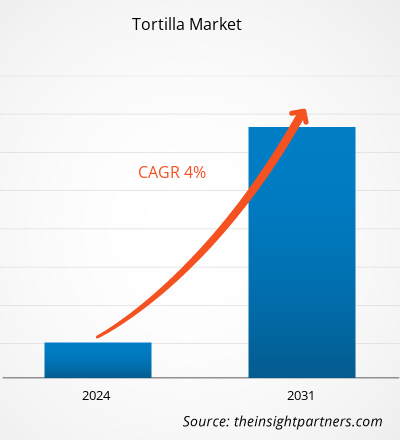Der Tortilla-Markt soll von 33,09 Milliarden US-Dollar im Jahr 2023 auf 45,18 Milliarden US-Dollar im Jahr 2031 wachsen; von 2023 bis 2031 wird eine durchschnittliche jährliche Wachstumsrate (CAGR) von 4,0 % erwartet. Die steigende Nachfrage nach Bio- und Clean-Label-Lebensmitteln dürfte auch in den kommenden Jahren ein wichtiger Trend auf dem Tortilla-Markt bleiben.
Tortilla-Marktanalyse
Der zunehmende Konsum gesunder Lebensmittel zur Vorbeugung von Gesundheitsproblemen wie chronischen Lungenerkrankungen, Diabetes, Herzerkrankungen, Fettleibigkeit und dem metabolischen Syndrom steigert die Nachfrage nach glutenfreien Lebensmitteln wie Tortillas. Glutenfreie Tortillas werden aus Reismehl, Maismehl oder Tapiokamehl hergestellt. Viele Menschen probieren neue Diäten wie Keto- oder Paleo-Diäten aus. Darüber hinaus ernähren sich manche Menschen aufgrund ihrer bestehenden Erkrankungen glutenfrei. Darüber hinaus konzentrieren sich Hersteller auf die Entwicklung und Markteinführung glutenfreier Produkte, um der steigenden Nachfrage der Verbraucher gerecht zu werden. So stellte Mission Foods 2021 sein gesünderes Tortilla-Angebot mit zwei neuen Sorten vor: Mandelmehl-Tortillas und Blumenkohl-Tortillas. Beide sind zertifiziert glutenfrei und vegan. Daher wird erwartet, dass die zunehmende Präferenz für glutenfreie Produkte im Prognosezeitraum große Chancen für den Tortilla-Markt schafft.Marktübersicht für Tortillas
Tortillas sind runde, dünne Fladenbrote aus Mais, Weizen oder anderen Getreidesorten. Mehrkorn-Tortillas werden aus Getreidemischungen wie Mais, Weizen, Reis und Linsen hergestellt. Da die Verbraucher gesundheitsbewusster werden und von den gesundheitlichen Vorteilen der von ihnen konsumierten Produkte ausgehen, steigt die Nachfrage nach Mehrkorn-Tortillas, vegetarischen Tortillas und glutenfreien Tortillas. Blauer Mais erfreut sich zunehmender Beliebtheit bei der Herstellung von Tortillas, da er proteinreich und stärkeärmer als herkömmlicher Mais ist. Zudem hat er einen niedrigeren glykämischen Index, wodurch der Blutzuckerspiegel nicht plötzlich ansteigt. All diese Faktoren treiben die Nachfrage nach Tortillas aus blauem Mais an und beflügeln das Wachstum des Tortillamarktes.Passen Sie diesen Bericht Ihren Anforderungen an
Sie erhalten kostenlos Anpassungen an jedem Bericht, einschließlich Teilen dieses Berichts oder einer Analyse auf Länderebene, eines Excel-Datenpakets sowie tolle Angebote und Rabatte für Start-ups und Universitäten.
Tortilla-Markt: Strategische Einblicke

-
Holen Sie sich die wichtigsten Markttrends aus diesem Bericht.Dieses KOSTENLOSE Beispiel umfasst Datenanalysen, die von Markttrends bis hin zu Schätzungen und Prognosen reichen.
Treiber und Chancen auf dem Tortilla-Markt
Strategische Initiativen wichtiger Marktteilnehmer treiben das Marktwachstum voran
Tortilla-Hersteller ergreifen verschiedene strategische Initiativen, darunter die Einführung neuer Produkte, die Ausweitung der Produktionskapazität, Fusionen und Übernahmen sowie Kooperationen, um ihre Marktposition zu verbessern und die wachsende Nachfrage von Kunden weltweit zu erfüllen. So brachte Garden Veggie Snacks, die Marke von Hain Celestial, im Januar 2024 die Tortilla-Chips Flavor Burst Nacho Cheese und Zesty Ranch auf den Markt. Diese Tortilla-Chips sind zertifiziert glutenfrei und vereinen den Geschmack und die Nährstoffe von Gemüse wie Spinat, Rote Bete, Paprika, Karotte und Tomate. Das wachsende Gesundheitsbewusstsein der Verbraucher steigert die Nachfrage nach solchen Tortilla-Produkten mit verschiedenen gesundheitsbezogenen Angaben und veranlasst die Hersteller, Produkte mit innovativen Geschmacksrichtungen auf den Markt zu bringen. Darüber hinaus brachte Hilo Life, ein Unternehmen des Hive-Accelerators von PepsiCo, im März 2021 Tortilla-Chips auf Mandelmehlbasis auf den Markt, die sich an keto- und kohlenhydratbewusste Verbraucher richten. Die Chips werden aus entfettetem Mandelmehl hergestellt und liefern mehr Protein als herkömmliches Mandelmehl, ohne den Fettgehalt zu erhöhen.Darüber hinaus weiten Tortilla-Hersteller ihre Geschäftspräsenz in verschiedenen Ländern aus. Paulig, eine Muttergesellschaft von Poco Loco und Santa Maria, eröffnete im September 2022 eine neue Tortilla-Fabrik in Belgien, um die wachsende Nachfrage nach Tex-Mex-Produkten in Europa zu decken.
Zunehmende Präferenz für glutenfreie Produkte schafft Chancen auf dem Tortilla-Markt im Prognosezeitraum
Die Prävalenz von Zöliakie nimmt in verschiedenen Ländern weltweit zu. Laut den 2021 von Epidemiology, Presentation, and Diagnosis of Celiac Disease veröffentlichten Daten werden Zöliakiefälle weltweit registriert, entgegen früherer Annahmen, dass sie nur Menschen in West- und Nordeuropa betrifft. Zöliakie kann bei manchen Patienten Schilddrüsen-/Typ-1-Diabetes verursachen oder die Darmschleimhaut schädigen. Daten von Beyond Celiac zeigen, dass schätzungsweise 1 von 133 Amerikanern (also etwa 1 % der Bevölkerung) an Zöliakie leidet. In den USA deuten aktuelle Screening-Studien auf eine potenziell höhere Prävalenz als 1 % hin. Eine glutenfreie Ernährung kann helfen, die Auswirkungen von Zöliakie zu lindern, indem sie die Heilung des Darms fördert. Daher bevorzugen Verbraucher überwiegend glutenfreie Ernährung. Im Einklang mit dieser veränderten Präferenz entwickeln auch Tortilla-Hersteller glutenfreie Produkte, um der steigenden Nachfrage gerecht zu werden. Daher wird erwartet, dass die steigende Präferenz für glutenfreie Produkte im Prognosezeitraum erhebliche Chancen für den Tortilla-Markt schafft.Immer mehr gesundheitsbewusste Verbraucher ohne diagnostizierte Glutenunverträglichkeit ernähren sich im Rahmen eines umfassenderen Wellness-Lebensstils glutenfrei. Dieser Trend treibt Innovationen im Tortilla-Segment voran und ermutigt Hersteller, ihr Produktportfolio um alternative Mehlsorten wie Mais, Mandeln, Maniok und Kichererbsen zu erweitern. Diese glutenfreien Rezepturen berücksichtigen nicht nur Ernährungseinschränkungen, sondern sprechen auch Verbraucher an, die nach neuen Texturen und Nährwerten suchen.
Einzelhändler erweitern ihre Regalfläche für glutenfreie Artikel und signalisieren damit eine breitere Marktakzeptanz und steigende wirtschaftliche Rentabilität. Da Gastronomiebetriebe und Schnellrestaurants zunehmend glutenfreie Tortillas in ihre Menüs aufnehmen, eröffnet dies neue Einnahmequellen und vertieft die Marktdurchdringung.
Segmentierungsanalyse des Tortilla-Marktberichts
Schlüsselsegmente, die zur Ableitung der Tortilla-Marktanalyse beigetragen haben, sind Quelle, Produkttyp, Kategorie und Vertriebskanal.- Basierend auf der Quelle ist der Tortilla-Markt in Mais, Weizen und Sonstiges segmentiert. Das Maissegment hatte 2023 den größten Marktanteil.
- Nach Produkttyp ist der Markt in Tortilla-/Tostada-Chips, Taco-Schalen, Tortilla-Wraps und Sonstiges segmentiert. Das Segment Tortilla-/Tostada-Chips hatte 2023 den größten Marktanteil.
- Basierend auf der Kategorie ist der Tortilla-Markt in Bio und konventionell unterteilt. Das Bio-Segment wird voraussichtlich von 2023 bis 2031 eine höhere CAGR verzeichnen.
- In Bezug auf den Vertriebskanal ist der Markt in Supermärkte und Hypermärkte, Convenience Stores, Online-Einzelhandel und Sonstiges segmentiert. Das Segment Supermärkte und Verbrauchermärkte hielt im Jahr 2023 einen bedeutenden Marktanteil.
Geografische Analyse des Marktanteils von Tortillas
Der geografische Umfang des Berichts zum Tortilla-Markt ist hauptsächlich in fünf Regionen unterteilt: Nordamerika, Asien-Pazifik, Europa, Naher Osten und Afrika sowie Süd- und Mittelamerika.Nordamerika dominierte den Tortilla-Markt im Jahr 2023, während für den Asien-Pazifik-Raum von 2023 bis 2031 die höchste durchschnittliche jährliche Wachstumsrate erwartet wird. Australien ist einer der am schnellsten wachsenden Märkte für Tortillas im Asien-Pazifik-Raum. In dem Land wird die Beliebtheit von Tortillas durch ihre zunehmende Verfügbarkeit in verschiedenen Einzelhandelskanälen beeinflusst, darunter traditionelle Lebensmittelgeschäfte, Verbrauchermärkte, Convenience Stores und der Online-Handel. Verbraucher suchen nach Bequemlichkeit, und Hersteller führen ständig neue Produktvarianten, Geschmacksprofile, gesündere Alternativen sowie glutenfreie und pflanzliche Optionen ein, um den unterschiedlichen kulinarischen Bedürfnissen und Vorlieben gerecht zu werden und Verbraucher anzusprechen, die schnelle Mahlzeiten oder Snacks suchen. So führte Doritos im Oktober 2023 eine neue Geschmacksrichtung ein: Koriander. Die Geschmacksrichtung Koriander wird als aromatisch und herrlich seifig beschrieben und bietet ein kräftiges und einzigartiges Geschmackserlebnis. Neben Australien wird auch für den japanischen Tortilla-Markt von 2023 bis 2031 ein deutliches Wachstum erwartet. Die wachsende Beliebtheit von Tortillas in Japan wird auf eine Fusion japanischer und mexikanischer kulinarischer Einflüsse sowie auf innovative Angebote in Convenience Stores zurückgeführt. Die kulinarische Landschaft in Japan erlebt einen faszinierenden Trend, da japanische Verbraucher zunehmend an Fusionsküche interessiert sind. Es besteht ein wachsendes Interesse daran, die traditionelle japanische Sushi-Kultur mit lateinamerikanischen Grundnahrungsmitteln, insbesondere der mexikanischen Küche, zu verbinden. Diese kulinarische Fusion wirkte sich positiv auf die japanische Tortilla-Industrie aus und führte zu einem deutlichen Anstieg der Umsätze. Convenience Stores in Japan führen neue Food-Trends ein und wichtige Ketten wie Seven-Eleven Japan und FamilyMart bringen limitierte Editionen wie Taco-Wraps auf den Markt. Diese kleinen Schritte machen japanische Verbraucher mit der mexikanischen Küche vertraut und tragen zum Trend auf dem japanischen Markt bei.
Regionale Einblicke in den Tortilla-Markt
Die regionalen Trends und Faktoren, die den Tortilla-Markt im Prognosezeitraum beeinflussen, wurden von den Analysten von Insight Partners ausführlich erläutert. In diesem Abschnitt werden auch die Marktsegmente und die geografische Lage in Nordamerika, Europa, Asien-Pazifik, dem Nahen Osten und Afrika sowie Süd- und Mittelamerika erörtert.
Tortilla-Markt
Die Analysten von The Insight Partners haben die regionalen Trends und Faktoren, die den Tortilla-Markt im Prognosezeitraum beeinflussen, ausführlich erläutert. In diesem Abschnitt werden auch die Marktsegmente und die geografische Lage in Nordamerika, Europa, dem asiatisch-pazifischen Raum, dem Nahen Osten und Afrika sowie Süd- und Mittelamerika erörtert.Umfang des Tortilla-Marktberichts
| Berichtsattribut | Einzelheiten |
|---|---|
| Marktgröße in 2023 | US$ 33.09 Billion |
| Marktgröße nach 2031 | US$ 45.18 Billion |
| Globale CAGR (2023 - 2031) | 4.0% |
| Historische Daten | 2021-2022 |
| Prognosezeitraum | 2024-2031 |
| Abgedeckte Segmente |
By Quelle
|
| Abgedeckte Regionen und Länder |
Nordamerika
|
| Marktführer und wichtige Unternehmensprofile |
|
Dichte der Marktteilnehmer auf dem Tortilla-Markt: Verständnis ihrer Auswirkungen auf die Geschäftsdynamik
Der Tortilla-Markt wächst rasant, angetrieben von der steigenden Endverbrauchernachfrage aufgrund von Faktoren wie sich entwickelnden Verbraucherpräferenzen, technologischem Fortschritt und einem stärkeren Bewusstsein für die Produktvorteile. Mit steigender Nachfrage erweitern Unternehmen ihr Angebot, entwickeln Innovationen, um den Bedürfnissen der Verbraucher gerecht zu werden, und nutzen neue Trends, was das Marktwachstum weiter ankurbelt.

- Holen Sie sich die Tortilla-Markt Übersicht der wichtigsten Akteure
Neuigkeiten und aktuelle Entwicklungen auf dem Tortilla-Markt
Der Tortilla-Markt wird durch die Erhebung qualitativer und quantitativer Daten aus Primär- und Sekundärforschung bewertet, die wichtige Unternehmenspublikationen, Verbandsdaten und Datenbanken umfasst. Eine wichtige aktuelle Entwicklung auf dem Tortilla-Markt wird nachfolgend erwähnt:- Paulig hat das spanische Unternehmen Liven übernommen, um sein Tex-Mex- und Snack-Geschäft in Europa anzukurbeln. (Quelle: Unternehmenswebsite, Januar 2022)
Bericht zum Markt für Tortillas: Umfang und Ergebnisse
Der Bericht „Marktgröße und -prognose für Tortillas (2021–2031)“ bietet eine detaillierte Analyse des Marktes in den folgenden Bereichen:
- Marktgröße und -prognose für Tortillas auf globaler, regionaler und Länderebene für alle abgedeckten wichtigen Marktsegmente
- Markttrends und Marktdynamiken wie Treiber, Einschränkungen und wichtige Chancen
- Detaillierte Porter's Five Forces- und SWOT-Analyse
- Marktanalyse für Tortillas mit wichtigen Markttrends, globalen und regionalen Rahmenbedingungen, wichtigen Akteuren, Vorschriften und aktuellen Marktentwicklungen
- Branchenlandschaft und Wettbewerbsanalyse mit Marktkonzentration, Heatmap-Analyse, prominenten Akteuren und aktuellen Entwicklungen für den Tortilla-Markt
- Detaillierte Unternehmensprofile
- Historische Analyse (2 Jahre), Basisjahr, Prognose (7 Jahre) mit CAGR
- PEST- und SWOT-Analyse
- Marktgröße Wert/Volumen – Global, Regional, Land
- Branchen- und Wettbewerbslandschaft
- Excel-Datensatz
Aktuelle Berichte
Erfahrungsberichte
Grund zum Kauf
- Fundierte Entscheidungsfindung
- Marktdynamik verstehen
- Wettbewerbsanalyse
- Kundeneinblicke
- Marktprognosen
- Risikominimierung
- Strategische Planung
- Investitionsbegründung
- Identifizierung neuer Märkte
- Verbesserung von Marketingstrategien
- Steigerung der Betriebseffizienz
- Anpassung an regulatorische Trends






















 Kostenlose Probe anfordern für - Tortilla-Markt
Kostenlose Probe anfordern für - Tortilla-Markt